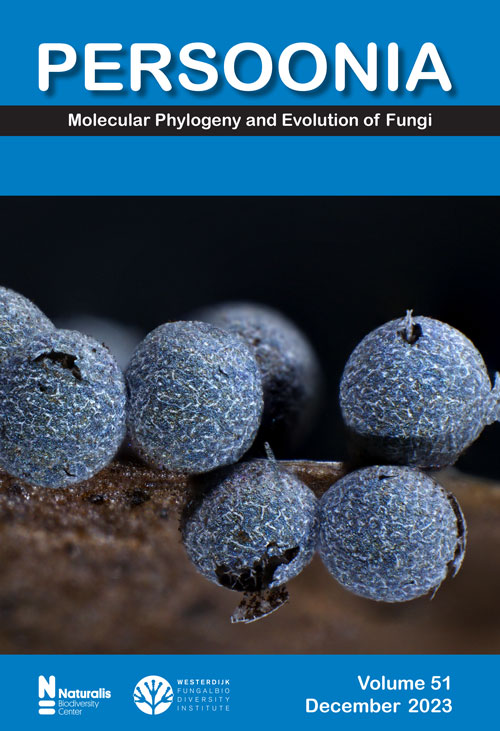Saccharomycetaceae: delineation of fungal genera based on phylogenomic analyses, genomic relatedness indices and genomics-based synapomorphies
IF 9.5
1区 生物学
Q1 MYCOLOGY
引用次数: 0
Abstract
A correct classification of fungi, including yeasts, is of prime importance to understand fungal biodiversity and to communicate about this diversity. Fungal genera are mainly defined based on phenotypic characteristics and the results of single or multigene-based phylogenetic analyses. However, because yeasts often have less phenotypic characters, their classification experienced a strong move towards DNA-based data, from short ribosomal sequences to multigene phylogenies and more recently to phylogenomics. Here, we explore the usefulness of various genomics-based parameters to circumscribe fungal genera more correctly taking the yeast domain as an example. Therefore, we compared the results of a phylogenomic analysis, average amino acid identity (AAI) values, the presence of conserved signature indels (CSIs), the percentage of conserved proteins (POCP) and the presence- absence patterns of orthologs (PAPO). These genome-based metrics were used to investigate their usefulness in demarcating 13 hitherto relatively well accepted genera in Saccharomycetaceae, namely Eremothecium, Grigorovia, Kazachstania, Kluyveromyces, Lachancea, Nakaseomyces, Naumovozyma, Saccharomyces, Tetrapisispora, Torulaspora, Vanderwaltozyma, Zygosaccharomyces and Zygotorulaspora. As a result, most of these genera are supported by the genomics-based metrics, but the genera Kazachstania , Nakaseomyces and Tetrapisispora were shown to be genetically highly diverse based on the above listed analyses. Considering the results obtained for the presently recognized genera, a range of 80–92% POCP values and a range of 60–70 % AAI values might be valuable thresholds to discriminate genera in Saccharomycetaceae. Furthermore, the genus-specific genes identified in the PAPO analysis and the CSIs were found to be useful as synapomorphies to characterize and define genera in Saccharomycetaceae. Our results indicate that the combined monophyly-based phylogenomic analysis together with genomic relatedness indices and synapomorphies provide promising approaches to delineating yeast genera and likely those of filamentous fungi as well. The genera Kazachstania, Nakaseomyces and Tetrapisispora are revised and we propose eight new genera and 41 new combinations.酵母菌科:基于系统发生组分析、基因组亲缘关系指数和基于基因组学的异构体的真菌属划分
对包括酵母菌在内的真菌进行正确分类,对于了解真菌的生物多样性和交流这种多样性至关重要。然而,由于酵母菌的表型特征通常较少,因此它们的分类经历了从短核糖体序列到多基因系统发育,以及最近的系统发生组学等基于 DNA 数据的重大转变。在此,我们以酵母菌为例,探讨各种基于基因组学的参数对更正确地划分真菌属的有用性。因此,我们比较了系统发生组分析的结果、平均氨基酸同一性(AAI)值、是否存在保守的特征性嵌合体(CSIs)、保守蛋白质的百分比(POCP)以及同源物的存在-缺失模式(PAPO)。这些基于基因组的指标被用来研究它们在划分酵母菌科中 13 个迄今为止相对公认的属的有用性,这 13 个属是 Eremothecium、Grigorovia、Kazachstania、Kluyveromyces、Lachancea、Nakaseomyces、Naumovozyma、Saccharomyces、Tetrapispora、Torulaspora、Vanderwaltozyma、Zygosaccharomyces 和 Zygotorulaspora。 因此,这些属中的大多数都得到了基于基因组学指标的支持,但根据上述分析,Kazachstania 属、Nakaseomyces 属和 Tetrapispora 属在基因上具有高度多样性。考虑到目前已知属的结果,80-92% 的 POCP 值范围和 60-70% 的 AAI 值范围可能是区分酵母菌科属的有价值的临界值。此外,在 PAPO 分析和 CSIs 中发现的属特异性基因可作为同源物来描述和定义酵母菌科的属。我们的研究结果表明,将基于单系的系统发生组分析与基因组亲缘关系指数和同形异构体相结合,为划分酵母菌属以及丝状真菌属提供了很好的方法。我们对 Kazachstania 属、Nakaseomyces 属和 Tetrapisispor 属进行了修订,并提出了 8 个新属和 41 个新组合。
本文章由计算机程序翻译,如有差异,请以英文原文为准。
求助全文
约1分钟内获得全文
求助全文
来源期刊

Persoonia
MYCOLOGY-
CiteScore
17.70
自引率
5.50%
发文量
10
审稿时长
3 months
期刊介绍:
Persoonia aspires to publish papers focusing on the molecular systematics and evolution of fungi. Additionally, it seeks to advance fungal taxonomy by employing a polythetic approach to elucidate the genuine phylogeny and relationships within the kingdom Fungi. The journal is dedicated to disseminating high-quality papers that unravel both known and novel fungal taxa at the DNA level. Moreover, it endeavors to provide fresh insights into evolutionary processes and relationships. The scope of papers considered encompasses research articles, along with topical and book reviews.
 求助内容:
求助内容: 应助结果提醒方式:
应助结果提醒方式:


